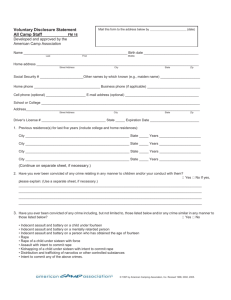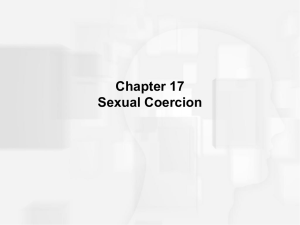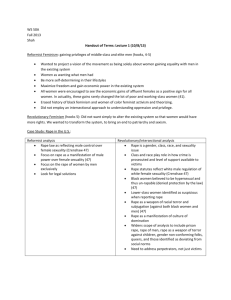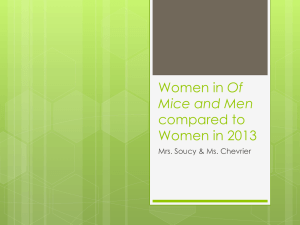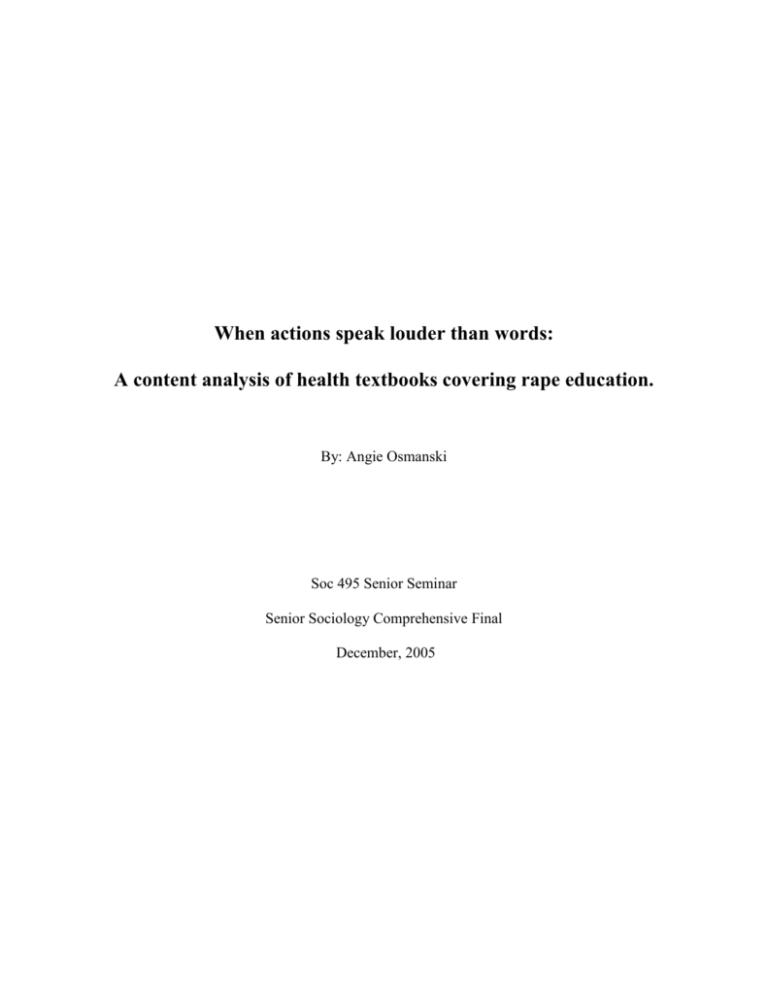
When actions speak louder than words:
A content analysis of health textbooks covering rape education.
By: Angie Osmanski
Soc 495 Senior Seminar
Senior Sociology Comprehensive Final
December, 2005
When actions speak louder than words:
A content analysis of health textbooks covering rape education.
By: Angie Osmanski
ABSTRACT
This study, a content analysis of health textbooks covering rape education,
focuses on how health textbooks socially construct the ‘rape culture’ we live in today.
Rape and sexual assault is not a new issue, it has only recently been getting the attention
it needs. In order for society to change their views on rape, society has to begin teaching
young minds the importance of rape and sexual assault. This study indicates how the
increase of rape education has become more prominent in the past few years. By looking
at health textbooks one can learn what is available to teach students and help to inform
them about rape and sexual assault.
1
Introduction
Rape education began in the 1960s and since then has seen promising results.
Even though rape today is the most unreported crime, there has been an increase in the
reporting of rape since the ‘60s. This indicates rape education is informing society that
rape is a crime and will not be tolerated. Rape education began with spreading the word
about rape as a crime and is now trying to prevent the assaults from occurring. In order
to do this we have to look at what and how society is being taught about the occurrence
of rape. Teachers are said to have an influence of the minds of the future. Therefore, by
looking at textbooks, a key component of a teacher’s educational tool, we can learn what
is available for those teachers’ to teach about rape. The purpose of this paper is to
examine how health textbooks socially construct our cultures beliefs about sex and rape
myths.
Literature Review
Despite the presence of rape education in schools, rape is still a common
occurrence in the United States with one in three girls and one in five boys reported being
raped before the age of 18 (Illinois Coalition Against Sexual Assault, ICASA, 2002). As
early as 1965, adolescents were participating in rape and sex education (Calderwood,
1965). Furthermore, Calderwood (1965) notes that parents were unaware that children of
a young age would like to talk about sex education. The proceeding studies have
examined the link between rape and sex education.
In 1980, the Community Action Strategies to Stop Rape (CASSR) discussed ways
to create social change regarding rape by empowering women in the community,
2
agencies, and institutions. They found that by empowering women, the knowledge of
rape was more accurate, attitudes and beliefs became more pro-feminist, and the
community’s general awareness of rape increased. Their results showed the promise of
establishing feminist rape education.
Fonow, Richardson, and Wemmerus (1992) specifically studied the impact of
rape education among college students. While their results showed heightened awareness
of rape myths after rape education, the differences between men and women’s thoughts
about rape did not change. They discovered that women’s beliefs about rape were
reinforced and supported through rape education, while the men’s beliefs were
confronted through rape education. Therefore, they proposed a need for a more dramatic
format for rape education instead of the typical lecture and video. Fonow, Richardson,
and Wemmerus argued that rape education needs to include a discussion of social control.
The idea of “rape as sex” needs to be addressed in order to eliminate the differences
between men and women’s thoughts about rape as a crime. According to Fonow,
Richardson, and Wemmerus (1992; 119) being able to discuss “both the erotic and the
dominance themes that characterize our culture’s representations of rape” would help in
decreasing the false rape beliefs. False rape beliefs are correlated with “blaming the
victim, adversarial sexual beliefs, and conservative gender roles” (Fonow, Richardson,
and Wemmerus, 1992; 119).
Foubert and Marriott (1997) focused on teaching rape education to men who have
never been convicted of rape. By using an all-male peer education format, the results
were promising. The program not only educated men but also decreased the likelihood of
one becoming a perpetrator of rape. Foubert’s (2000) follow-up study revealed how the
3
actual behavior, sexual coercive behavior, was not accurately measured; therefore, he
argues that there needs to be different ways of measuring the impact of sexual coercive
behavior.
Johnson, et.al. (2001) also focused on teaching men, who were not convicted of
rape, to help survivors cope with rape. Due to cultural attitudes, men are less likely to
realize the effects of rape upon the victim. Johnson, et.al, describes how current rape
prevention causes men to be defensive. They found that men are interested in being a
positive supporter to victims of rape, but the men in general feel inadequate to help.
Therefore, by teaching men how to help victims of rape cope with the traumatic
experience, these men learn to understand the affects of rape. By changing the focus
from “men are the villain and cause rape” to “men can help,” rape education becomes
less-threatening for men, and more likely to result in fewer rapes.
Greytak (2003) found that there is a lack of information about the impact of rape
education and the occurrence of rape in high school students. Due to the difficulty of
doing research in a high school setting, studies are more concentrated on the effectiveness
of rape education in a college setting. Greytak (2003) argues the research of rape and sex
education in high schools is very limited and needs to have further analysis.
Hall (2004) believes that by challenging rape prevention’s habitual
reinforcement of the notion that fear is a woman’s best line of defense then the
public will be able to shift the focus of rape. Hall concludes the energy used in
the anti-rape movement should begin to focus on three fronts: shifting the focus
from women to men; stressing that women are not the only ones who are victims;
and trying to change the publics’ misconceptions of rape’s naturalness.
4
In order to determine what is available for rape education in school curriculum,
the following research will focus on the textbooks used in seventh and eighth grade, high
school, and college level health textbooks in order to see how rape is socially constructed.
Theory: The Social Construction of Rape
Generally understood, social problems are social conditions causing harm upon
individuals or groups in society at a particular time and place. Social problems consist of
objective conditions and subjective definitions. Since the world is too large and complex
to personally know about every social problem condition, individuals have to categorize
by “typification.” Loseke (2003; 17) describes typification as “an image in our heads of
typical kinds of things; … to have an image of the typical.” By utilizing a social
construction perspective, Loseke (2003) in Thinking About Social Problems, examines
the process of constructing social problems. Loseke (2003; 18) claims that people create
meanings for objects or ideas, like rape.
Loseke challenges the objective perspective of social problems as the only way to
examine social problems. The objective perspective holds that social problems are
“measurable and widespread conditions in the environment and they are about the living,
breathing people who are hurt by these conditions or who create these conditions”
(Loseke, 2003; 7). Focusing on the objective perspective means people rely on objective
indicators such as statistics or results of tests. For example, stating that one in three girls
and one in five boys are sexually assaulted by the age of 18, or that someone is more
likely to be sexually assaulted by someone they know then a stranger are both objective
indicators giving evidence there is a social problem. By contrast, the subjective view of a
5
social problem views a social problem is what individuals believe to be a social problem
(Best, 1995). “People’s ideas about risk matter more than the actual risk measured by
objective indicators” (Loseke, 2003; 9).
According to a subjective constructionist perspective, defining rape as a social
problem begins with someone, a “claims-maker,” creating meaning about the act of
sexual assault. Loseke (2003) and Best (1995) describe those who are defining a social
problem as a claims-maker. Claims-makers about rape are typically individuals or
organizations in the media and the educational system. For example, information about
rape is presented in textbooks, thus textbook authors themselves act as claims-makers.
Claims-makers not only bring social problems to the public’s attention, but they also
shape the public’s sense of the problem occurring by creating subjective meanings for the
social condition.
Loseke (2003; 26) defines a claim as “any verbal, visual, or behavioral statement
that seeks to persuade audience members to define a condition as a social problem.”
Verbal or rhetoric claims are statements presenting social problems that appear on flyers,
mailings, newspapers, textbooks, and the internet. Visual claims can be pictures, or any
images seen in films, TV programs, and so on. For example, a picture of a woman that
has been severely battered is a visual claim about how domestic violence and rape can
become life threatening. Behavioral claims involve the act of doing something “to
disrupt social life in order to persuade audience members to listen to verbal claims, and to
see visual claims” (Loseke, 2003; 26). This may include behaviors such as the protests of
the civil rights and women’s movements of the ’50’s and ’60’s or women protesting
outside a court hearing about a rape case.
6
Claims-makers construct a diagnostic framework, or causes of the social
condition, by using conditions of particular categories which, in turn, construct blame and
responsibility. There are two broad types of categorizing conditions within the diagnostic
framework: social conditions or individuals (Loseke, 2003). For example, schools
exemplify a social structure by the way they frame adolescents’ views of rape. By
contrast, being prejudice, racist, or homophobic are individual attitudes that frame beliefs
of rape.
Schools teach, or inform, their students about rape through both curriculum and
textbooks. Textbooks frame the views and beliefs of rape that individual teachers present
to their students. Thus, textbooks are constructing individuals’ thoughts and beliefs about
rape and deserve further analysis.
Methods
Data for this study was obtained using a content analysis of eight health textbooks
ranging from seventh grade to college level (See Appendix A for a list). A content
analysis is “a systematic analysis of the content rather than the structure of a
communication, such as a written work, speech, or film, including the study of thematic
and symbolic elements to determine the objective or meaning of the communication”
(www.dictionary.com).
Three textbooks were obtained from teachers in the South Bend, Indiana area
schools. Health teachers were identified by the S.O.S. Madison Center prevention
education department. Two textbooks came from Illinois through personal contacts, and
7
the last three were obtained by random sample of resources in the Learning Tree of Saint
Mary’s College, Indiana.
One textbook was seventh grade level and one was eighth grade level, both were
from 2005. The publication dates of the five textbooks at the high school level ranged
from 1987 to 2005. The one college level textbook was from 1992. The amount of
information on rape education ranged anywhere from one sentence to a little over ten
pages in textbooks that had a total between 309 to 785 pages.
Coding sheets were used to identify the key variables including: how rape is
defined, how textbooks definitions vary according to age of target audience, what, if any,
cultural myths were included in the textbooks. Cultural myths include ideas such as:
most rapes are committed by strangers, rape does not happen very often, victims of rape
are simply trying to get attention, rape is not that harmful, rape only happens to women,
women who dress provocatively want to have sex, if women are taken to dinner by men
they owe him sex, when a women does not fight or say “no,” then the action is not rape,
and husbands do not rape their wives.
FINDINGS
Table 1 shows the targeted age groups, how the information is worded, and how
many pages are devoted to rape education. The textbooks range from 309 to 785 pages
and on average the textbooks are 580.5 pages. The amount devoted to rape education
ranges from one sentence (1991) to a little over ten pages (2005) and on average about
five pages. The percent devoted to rape education ranged from 0.16 (1991) percent to
1.40 (1994) percent, and on average 0.85 percent. Rape education usually shows up in
8
sections involving prevention and resolution of conflicts and violence. There was only
one textbook, Holt Health, that had a section specifically for abuse, Preventing Abuse
and Violence. The data indicates a slight increase over time of the amount of rape
education included in textbooks.
Table 1 SUMMARY OF PAGES DEVOTED TO RAPE EDUCATION IN TEXTBOOKS
Book Title
Section (s)
Information Appears
Health & Safety
For You (1987)
Concepts &
Applications
Wellness (1991)
Life Choices:
Health Concepts
& Strategies
(1992)
Holt Health
(1994)
Personal Safety
Safety & Emergency
Preventing Sexually Transmitted
Diseases
Glencoe Health
(2003)
Glencoe Teen
Health: Course 2
(2005)
Glencoe Teen
Health: Course 3
(2005)
Glencoe Health
(2005)
Total
Textbook
Pages
Pages Dedicated to
Rape Education
Frequency
451
1.25
1.25/451
% Rape
Education
in each
textbook
0.28 %
309
.5
5/309
0.16 %
Intimacy, Pairing, &
Commitment
621
2.5
2.5/621
0.40 %
Adolescnece: Relationships &
Responsibilities
Skills for responsible sexual
behavior
Preventing Abuse & Violence
a) Abusive families
b) Sexual assault
c) Preventing violent conflict
Resolving Conflicts & Preventing
Violence
a) Strategies for avoiding
violence
b) Preventing abuse
Resolving Conflicts & Preventing
Violence
a) Preventing violence
b) Dealing with abuse and
finding help
Conflict Resolution
Avoiding & preventing violence
Preventing abuse
Family Relationships
a) Dealing with Family Crisis
Violence Prevention
a) Personal Safety
b) Keeping schools safe
c) Protecting yourself from
violence
677
9.5
9.5/677
1.40 %
793
4.5
4.5/793
0.57 %
445
5.5
5.5/445
1.24 %
563
5
5/563
0.89%
785
10.75
10.75/785
1.37 %
580.5
4.94
4.94/580.5
0.85%
Average Total:
9
Table 2 summarizes the context in which rape prevention is presented inside each
textbook. The textbooks below show a consistency of presenting types of abuse, sexual
and physical abuse, how or where to find help, safety precautions, and the cycle of abuse
or violence were most common. Rape education is, on a whole, touching only on the
surface of the rape. The pattern data indicates an increase of information on rape
education as the years pass, with the exception of Holt Health. The interesting aspect of
this table is how Glencoe Heath (2003) holds with the pattern even though the seventh
and eighth grade editions come after.
The results from both tables illustrate that the younger the targeted audience the
more emphasis is given to protect children from violence in general while covering rape
and other forms of abuse. The older the targeted age group goes, the more detail
information is given about rape and other forms of abuse (how it happens, the victims’
feelings, how to get help for the victims, as well as, the abuser, etc).
10
Table 2 HOW RAPE EDUCATION IS PRESENTED
Book Title
Health & Safety For You (1987)
Concepts & Applications Wellness
(1991)
Life Choices: Health Concepts &
Strategies (1992)
Holt Health (1994)
Glencoe Health (2003)
Glencoe Teen Health: Course 2
(2005)
Glencoe Teen Health: Course 3
(2005)
Glencoe Health (2005)
Topics
Preventing assault at home, on the street, and in a car
Help for victim
Safer Sex: An individual responsibility
Are you saying that when a person forces sex during a date this is a violent crime?
How damaging is rape?
Don’t some people think that acquaintance rape is not really rape?
Aren’t date rapes equally common in all societies?
With all this confusion, what can men do to avoid being accused of rape?
Can rape occur between two people who have previously willingly had sex?
Do many cases of rape go unreported?
What can I do to avoid being a rape victim?
Table: Rape Prevention Tips
Child abuse (Physical abuse, Sexual abuse, and Emotional abuse)
Figure 20-1 Making responsible decisions: What should you do? A case of child abuse?
Help for abusive families
Sexual assault
Taking precaution against sexual assault
Figure 20-2 Myths & Facts About Rape
Preventing acquaintance rape
After a sexual assault
Dealing with internal pressures (Practicing self-control and Other ways to show love)
Dealing with external pressures (Resisting sexual pressure, Respecting others, and High risk situations)
Violence in Society: Violence & Teens
Types of abuse (Physical abuse and Sexual abuse)
Abuse in dating relationships
Rape & date rape
How to avoid abuse
Help for victims of abuse
Help for abuser
Violence prevention: Protecting yourself
What is abuse?
Types of abuse
Causes & effects of abuse
Why victims stay silent
Breaking the cycle of abuse
Where to find help
Shield yourself from violence at home & outdoors
Protecting yourself from violence
Protecting yourself from rape
Preventing violence
Forms of abuse (Physical abuse, Emotional abuse, and Sexual abuse)
Effects of abuse
The cycle of abuse
How to avoid abuse
Where to get help
Communication Skills: Helping the victim of abuse
Family Violence (Child Abuse and Effects of Abuse)
Breaking the Cycle of Violence
Avoiding Domestic Violence
Strategies for Staying Safe
Issues of School Violence (Sexual harassment)
Reducing the risk of violence (Recognizing warning signs and What you can do)
Why violence occurs
Sexual violence
Escaping & surviving a sexual attack
Types of abuse
Dating violence
Overcoming abuse
Teen Health: Culture & Community, When dating is dangerous
11
Discussion
Although rape has occurred for all recorded human history, only recently has
received general public awareness and inclusion within school curriculum. The
textbooks for this study demonstrate that rape is defined and explained more thoroughly
today than when rape education began in the 1960s. Textbooks explain how rape is
harmful, the kinds of help that are needed or required, and how individuals can change
their actions in order to prevent rape from occurring.
Only two textbook offered information on rape myths. Rape myths are often
constructed by the media, so that individuals believe misinformation while important
factual information is left out. Rape education is an effective way to inform children and
adolescents about this topic and to cause a change in the way they think about rape. For
example, rape myths help women to realize rape is not gender specific. Some of the
textbooks stated how men are less likely to report rape due to the way society views men
as the dominant gender. By changing attitudes and making more children and
adolescents aware of the facts about rape, children and adolescents may become more
comfortable reporting a rape.
However, textbooks, as a claims-maker, also can present a limited amount of rape
information provided leaving many questions unanswered. The textbooks in this study
frequently omitted the deception and manipulation that is involved in rape. Rape does
not always consist of a spontaneous action upon another; but can be an action that is
carefully planned and carried out. The one area of rape information that was omitted in
these textbooks was the fact that the offender may have anger problems, but those anger
problems can be controlled with some help. Clearly, not only the victim needs help, but
so does the offender.
12
Children and adolescents may not understand is how vulnerable they are.
Offenders choose children and adolescents because they will keep secrets or they are
easily bribed or threatened. The offender also knows that an adult is word is believed
more readily than a child or adolescent.
This study shows that rape prevention education has increased over the past 40
years, and how societal views on rape are limited to what is available in textbooks. Rape
prevention education may be beginning steps to stop the cycle of violence that exists as a
social problem in the United States today.
13
APPENDIX A: Health Textbooks
Anspaugh, D.J., Hamrick, M.H., & Rosato, F.D. 1991. Concepts & Applications
Wellness. Mosby Year Book. St. Louis, MO.
Bonekemper, T.W., Jones, L.H.T., and Tsumura, T.K. 1987. Health & Safety for You.
Mc-Graw Hill, Inc.
Bronson, M.H., Cleary, M.J., and Hubbard M.D. 2003. Glencoe Health. Glencoe/McGraw Hill. Woodland Hills, CA.
Bronson, M.H., Cleary, M.J., Hubbard, B.M, and Zike, D. 2005. Glencoe Teen Health:
Course 2. Glencoe/Mc-Graw Hill. Woodland Hills, CA.
Bronson, M.H., Cleary, M.J., Hubbard, B.M, and Zike, D. 2005. Glencoe Teen Health:
Course 3. Glencoe/Mc-Graw Hill. Woodland Hills, CA.
Bronson, M.H., Cleary, M.J., Mark, D., Middleton, K., and Zike, D. 2005. Glencoe
Health. Glencoe/Mc-Graw Hill. Woodland Hills, CA.
Gold R & Greenberg J. 1994. Holt Health. Holt, Rinehart, and Winston, Inc. Orlando,
FL.
Turner, L.W., Sizer F.S., Whitney, E.N., & Wills B.B. 1992. Life Choices: Health
Concepts & Strategies 2nd Edition. West Publishing Company. St. Paul, MN.
14
References
Best, J. 1995. Images of Issues: Typifying Contemporary Social Problems. 2nd ed. New
York: Aldine de Gruyter.
Calderwood, D. 1965. Adolescents’ views on sex education. Journal of
marriage and the family 27, 291-298.
Community Action Strategies to Stop Rape (CASSR). 1980. A rape prevention
program in an urban area. Signs 5, S238- S241.
Foubert, J.D. 2000. The longitudinal effects of a rape-prevention program on
fraternity men’s attitudes, behavioral intent, and behavior. Journal of
American College Health 48, 158-164.
Foubert, J.D. and Marriott, K.A. 1997. Effects of a sexual assault peer education
program on men’s belief in rape myths. Sex Roles: A Journal of Research 36,
259-269.
Johnson, E. J., Scheel, E.D., Schneider, M., and Smith, B. 2001. Making rape
education meaningful for men: The case for eliminating the emphasis on
men as perpetrators, protectors, or victims. Sociological Practice: A
Journal of Clinical and Applied Sociology 3, 257-278.
Illinois Coalition Against Sexual Assault (ICASA). 2005. www.icasa.org.
Loseke, D. 2003. Thinking about social problems: An Introduction to Constructionist
Perspectives. New York: Aldine de Gruyter.
15



